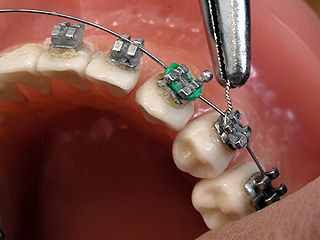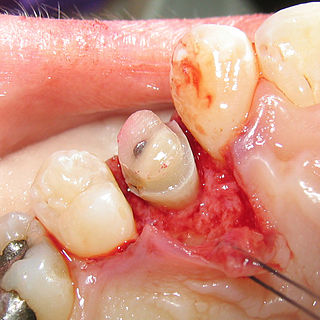Related Research Articles

Orthodontics is a dentistry specialty that addresses the diagnosis, prevention, management, and correction of mal-positioned teeth and jaws, as well as misaligned bite patterns. It may also address the modification of facial growth, known as dentofacial orthopedics.

Orthodontic retainers are custom-made devices, usually made of wires or clear plastic, that hold teeth in position after surgery or any method of realigning teeth. Once a phase of orthodontic treatment has been completed to straighten teeth, there remains a lifelong risk of relapse due to a number of factors: recoil of periodontal fibres, pressure from surrounding soft tissues, the occlusion and patient’s continued growth and development. By using retainers to hold the teeth in their new position for a length of time, the surrounding periodontal fibres adapt to changes in the bone which can help minimize any changes to the final tooth position after the completion of orthodontic treatment. Retainers may also be used to treat overjets.

Dental braces are devices used in orthodontics that align and straighten teeth and help position them with regard to a person's bite, while also aiming to improve dental health. They are often used to correct underbites, as well as malocclusions, overbites, open bites, gaps, deep bites, cross bites, crooked teeth, and various other flaws of the teeth and jaw. Braces can be either cosmetic or structural. Dental braces are often used in conjunction with other orthodontic appliances to help widen the palate or jaws and to otherwise assist in shaping the teeth and jaws.

Dental surgery is any of a number of medical procedures that involve artificially modifying dentition; in other words, surgery of the teeth, gums and jaw bones.

Clear aligners are orthodontic devices that are a transparent, plastic form of dental braces used to adjust teeth.

A palatal expander is a device in the field of orthodontics which is used to widen the upper jaw (maxilla) so that the bottom and upper teeth will fit together better. This is a common orthodontic procedure. Although the use of an expander is most common in children and adolescents 8–18 years of age, it can also be used in adults, although expansion is slightly more uncomfortable and takes longer. A patient who would rather not wait several months for the end result by a palatal expander may be able to opt for a surgical separation of the maxilla. Use of a palatal expander is most often followed by braces to then straighten the teeth.
Orthodontic technology is a specialty of dental technology that is concerned with the design and fabrication of dental appliances for the treatment of malocclusions, which may be a result of tooth irregularity, disproportionate jaw relationships, or both.

Crown lengthening is a surgical procedure performed by a dentist, or more frequently a periodontist, where more tooth is exposed by removing some of the gingival margin (gum) and supporting bone. Crown lengthening can also be achieved orthodontically by extruding the tooth.
Gingivectomy is a dental procedure in which a dentist or oral surgeon cuts away part of the gums in the mouth.

Crossbite is a form of malocclusion where a tooth has a more buccal or lingual position than its corresponding antagonist tooth in the upper or lower dental arch. In other words, crossbite is a lateral misalignment of the dental arches.

Angularis nigra, Latin for 'black angle', also known as open gingival embrasures, and colloquially known as "black triangle", is the space or gap seen at the cervical embrasure, below the contact point of some teeth. The interdental papilla does not fully enclose the space, leading to an aperture between adjacent teeth. This gap has many causes including gingival recession, and gingival withdrawal post-orthodontic work. Interdental "black triangles" were rated as the third-most-disliked aesthetic problem below caries and crown margins. Treatment of angularis nigra often requires an interdisciplinary approach, involving periodontal, orthodontic and restorative treatment. Possible treatments to correct angularis nigra include addition of composite resin in the space, veneer placement, or gum graft. Angularis nigra is generally only treated based on the aesthetic preference of the patient.
Interproximal reduction (IPR) is the practice of mechanically removing enamel from between the teeth to achieve orthodontic ends, such as to correct crowding, or reshape the contact area between neighboring teeth. After reducing the enamel, the procedure should also involve anatomic re-contouring and the protection of interproximal enamel surfaces.
Pre-eruption guidance is an orthodontic treatment method that allows for expansion of existing erupting teeth long before they appear in the mouth. The use off pre-eruption guidance appliances and the timing of extractions of certain deciduous teeth aligns the teeth naturally as opposed to orthodontic mechanical movement of permanent teeth into alignment after they have erupted. Research shows that pre-eruption guidance produces far more stable tooth alignment than alternative treatments.
Lingual braces are one of the many types of the fixed orthodontic treatment appliances available to patients needing orthodontics. They involve attaching the orthodontic brackets on the inner sides of the teeth. The main advantage of lingual braces is their near invisibility compared to the standard braces, which are attached on the buccal (cheek) sides of the tooth. Lingual braces were invented by Craven Kurz in 1976.
Charles J. Burstone was an American orthodontist who was notable for his contributions to biomechanics and force-systems in the field of orthodontics. He was well known for co-development of new orthodontic material such as beta titanium, nickel titanium, and long fiber-reinforced composite. He wrote more than 200 articles in scientific fields.

Anchorage in orthodontics is defined as a way of resisting movement of a tooth or number of teeth by using different techniques. Anchorage is an important consideration in the field of orthodontics as this is a concept that is used frequently when correcting malocclusions. Unplanned or unwanted tooth movement can have dire consequences in a treatment plan, and therefore using anchorage stop a certain tooth movement becomes important. Anchorage can be used from many different sources such as teeth, bone, implants or extra-orally.
Surgically assisted rapid palatal expansion (SARPE), also known as surgically assisted rapid maxillary expansion(SARME), is a technique in the field of orthodontics which is used to expand the maxillary arch. This technique is a combination of both Oral and Maxillofacial Surgery and Orthodontics. This procedure is primarily done in adult patients whose maxillary sutures are fused and cannot be expanded via other techniques.
Open bite is a type of orthodontic malocclusion which has been estimated to occur in 0.6% of the people in the United States. This type of malocclusion has no vertical overlap or contact between the anterior incisors. The term "open bite" was coined by Carevelli in 1842 2 as a distinct classification of malocclusion. Different authors have described the open bite in a variety of ways. Some authors have suggested that open bite often arises when overbite is less than the usual amount. Additionally, others have contended that open bite is identified by end-on incisal relationships. Lastly, some researchers have stated that a lack of incisal contact must be present to diagnose an open bite.
Laser gingivectomy is a dental procedure that recontours or scalpels the gingival tissue to improve long term dental health or aesthetics. Compared to conventional scalpel surgery, soft-tissue dental lasers, such as Laser diode, Nd:YAG laser, Er:YAG laser, Er,Cr:YSGG laser, and CO2 lasers, can perform this procedure, offering a precise, stable, bloodless, often less painful, and accelerated healing experience. However, the Laser diode gained more popularity due to its versatility, less interaction with hard tissue, ease of use, and the less expensive set up.
Orthodontic indices are one of the tools that are available for orthodontists to grade and assess malocclusion. Orthodontic indices can be useful for an epidemiologist to analyse prevalence and severity of malocclusion in any population.
References
- ↑ Ireland, Robert (2010-01-01), Ireland, Robert (ed.), "pericision", A Dictionary of Dentistry, Oxford University Press, doi:10.1093/acref/9780199533015.001.0001/acref-9780199533015-e-3290, ISBN 978-0-19-953301-5 , retrieved 2023-08-15
- ↑ Edwards, John G. (1988). "A long-term prospective evaluation of the circumferential supracrestal fiberotomy in alleviating orthodontic relapse". American Journal of Orthodontics and Dentofacial Orthopedics. 93 (5): 380–387. doi:10.1016/0889-5406(88)90096-0. ISSN 0889-5406 – via Elsevier Science Direct.